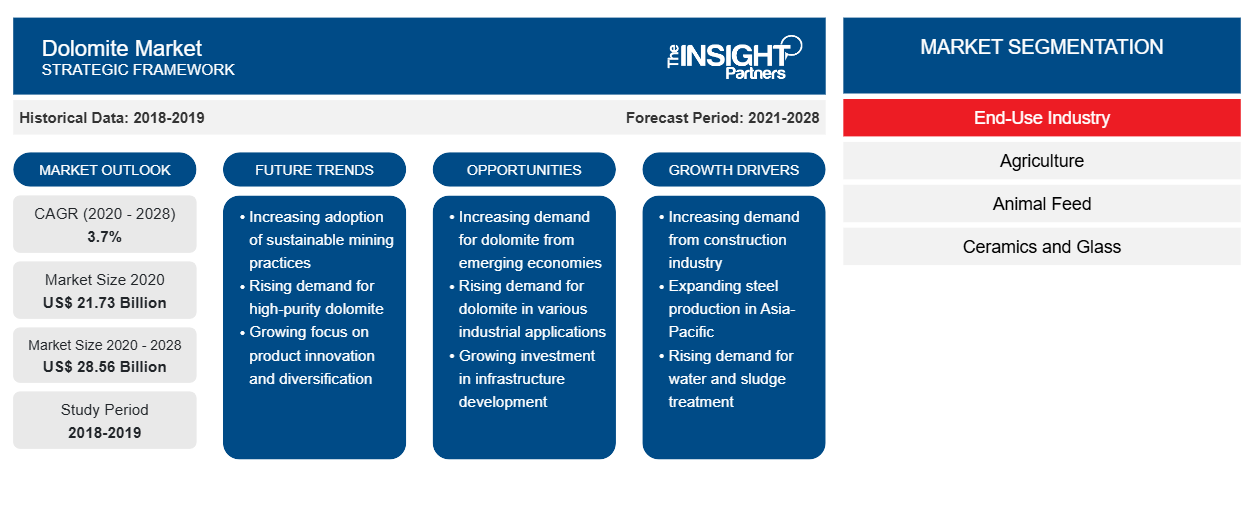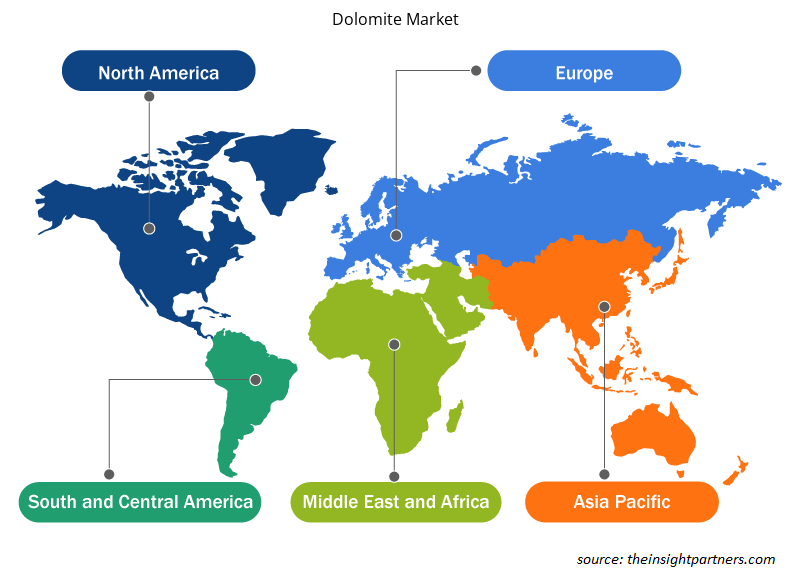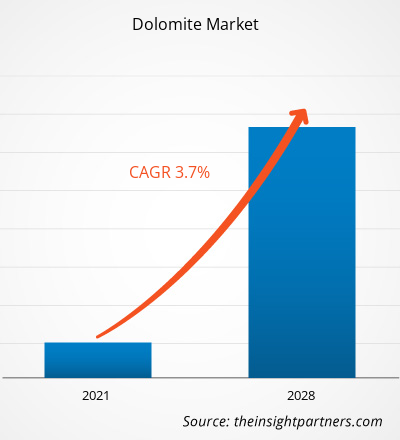The dolomite market is projected to grow from US$ 21,727.97 million in 2020 to US$ 28,558.14 million by 2028; it is expected to grow at a CAGR of 3.7% during 2021–2028.
Dolomite is an important material for ferro-alloys industries, and it is widely used in iron and steel plants. It also has vital application in the agriculture sector due to its ability to act as a soil conditioner and to balance the soil pH. The oil & gas, chemicals, rubber, mining & metals, water treatment, pharmaceuticals, and cosmetics are among other important end users of this substance. As these industries are witnessing considerable growth, especially in developing economies, the demand for dolomite is also growing continuously. However, adverse effects of mining activities on environment remain a concern for dolomite producers.
In 2020, Asia Pacific held the largest revenue share of the global dolomite market. The rapid growth of industrialization is driving investments in transport infrastructure in this region. Further, a rise in refractories production is propelling the demand for dolomite in the iron and steel industries in Asia Pacific. The region is home to the largest economies such as China and India, which are among the world’s largest consumers of refractories. China is a major producer of steel in the world, while India is witnessing an exponential growth in infrastructure. Thus, these factors are providing several growth opportunities for the dolomite market players in region.
Customize This Report To Suit Your Requirement
You will get customization on any report - free of charge - including parts of this report, or country-level analysis, Excel Data pack, as well as avail great offers and discounts for start-ups & universities
Dolomite Market: Strategic Insights

- Get Top Key Market Trends of this report.This FREE sample will include data analysis, ranging from market trends to estimates and forecasts.
You will get customization on any report - free of charge - including parts of this report, or country-level analysis, Excel Data pack, as well as avail great offers and discounts for start-ups & universities
Dolomite Market: Strategic Insights

- Get Top Key Market Trends of this report.This FREE sample will include data analysis, ranging from market trends to estimates and forecasts.
Impact of COVID-19 Pandemic on Dolomite Market
The ongoing COVID-19 pandemic has drastically altered the status of the chemical and materials sector and negatively impacted the growth of the dolomite mining market. The implementation of measures to combat the spread of SARS-CoV-2 has aggravated the situation. Industries such as construction, and iron and steel have been impacted by the sudden distortion in operational efficiencies and disruptions in the value chains attributable to the sudden shutdown of national and international boundaries. A significant decline in the growth of the several industrial sectors has led to reduced demand for dolomite. The shutdown of mining operations has created a hampered annual production performance. The long-term effects of COVID-19 pandemic on the mining industry will depend upon the length of lockdown periods and the ability of the industry players to resurge. As many countries are planning to revive their operations, the demand for dolomite is expected to rise globally in the coming months. The dolomite mining market players are focusing on the availability of supplies and manpower to achieve full operational levels.
Market Insights
Wide Range of Dolomite Applications to Fuel Dolomite Market Growth
Dolomite has a wide scope of applications in end-user industries such as construction, iron and steel, ferroalloys, ceramics and glass, agriculture, and animal feed. Its preference and adoption in industries depends on the grade of the rock. Dolomite is a commonly used substance in the construction industry because of its hardness and density. In the iron and steel industry, dolomite is used in three forms—raw dolomite, calcined dolomite, and sintered dolomite. Dolomite is used for acid neutralization in the chemicals industries and stream restoration projects. It is also used as a source of magnesia (MgO), a feed additive for livestock. Dolomite is used in the manufacture of automotive glass, construction glass, fiberglass, etc. Thus, with the growth of various end-user industries, such as construction, iron and steel, and ceramics and glass, the demand for dolomite is also growing.
End-Use Industry Insights
Based on end-use industry, the global dolomite market is segmented into agriculture, animal feed, ceramics and glass, iron and steel, construction, and others. The iron and steel segment held the largest share of the market in 2020. The iron and steel industry is highly driven by the growth of segments such as defense, heavy engineering, energy, and construction. The ever-increasing demand from these sectors owing to rapid urbanization and industrialization, especially in developing regions such as Asia Pacific, and South and Central America, is a major factor contributing to high demand for dolomite in the world, which is boosting the market growth.
A few of the key market players in the global dolomite market are Beihai Group; Calcinor; Essel Mining & Industries Limited; JFE GROUP; INCA MINING; LHOIST GROUP; Sibelco; RHI Magnesita GmbH; Arihant Min chem; and Omya AG.
Dolomite Market Regional Insights
The regional trends and factors influencing the Dolomite Market throughout the forecast period have been thoroughly explained by the analysts at Insight Partners. This section also discusses Dolomite Market segments and geography across North America, Europe, Asia Pacific, Middle East and Africa, and South and Central America.

- Get the Regional Specific Data for Dolomite Market
Dolomite Market Report Scope
| Report Attribute | Details |
|---|---|
| Market size in 2020 | US$ 21.73 Billion |
| Market Size by 2028 | US$ 28.56 Billion |
| Global CAGR (2020 - 2028) | 3.7% |
| Historical Data | 2018-2019 |
| Forecast period | 2021-2028 |
| Segments Covered |
By End-Use Industry
|
| Regions and Countries Covered | North America
|
| Market leaders and key company profiles |
Dolomite Market Players Density: Understanding Its Impact on Business Dynamics
The Dolomite Market is growing rapidly, driven by increasing end-user demand due to factors such as evolving consumer preferences, technological advancements, and greater awareness of the product's benefits. As demand rises, businesses are expanding their offerings, innovating to meet consumer needs, and capitalizing on emerging trends, which further fuels market growth.
Market players density refers to the distribution of firms or companies operating within a particular market or industry. It indicates how many competitors (market players) are present in a given market space relative to its size or total market value.
Major Companies operating in the Dolomite Market are:
- Beihai Group
- Calcinor
- Essel Mining & Industries Limited
- JFE GROUP
- INCA MINING
Disclaimer: The companies listed above are not ranked in any particular order.

- Get the Dolomite Market top key players overview
Report Spotlights
- Progressive industry trends in the dolomite market to help players develop effective long-term strategies
- Business growth strategies adopted by developed and developing markets
- Quantitative analysis of the dolomite market from 2019 to 2028
- Estimation of global demand for dolomite
- Porter’s Five Forces analysis to illustrate the efficacy of buyers and suppliers in the industry
- Recent developments to understand the competitive market scenario
- Market trends and outlook as well as factors governing the growth of the dolomite market
- Assistance in decision-making process by highlighting market strategies that underpin commercial interest, leading to the market growth
- Size of the dolomite market at various nodes
- Detailed market overview and segmentation, and the dolomite industry dynamics
- Size of the dolomite market in various regions with promising growth opportunities
Global Dolomite Market has been Segmented as Follows:
By End-Use Industry
- Agriculture
- Animal Feed
- Ceramics and Glass
- Iron and Steel
- Construction
- Others
Company Profiles
- Beihai Group
- Calcinor
- Essel Mining & Industries Limited
- JFE GROUP
- INCA MINING
- LHOIST GROUP
- Sibelco
- RHI Magnesita GmbH
- Arihant Min chem
- Omya AG
Frequently Asked Questions
Based on application, which segment held the fastest CAGR in the global dolomite market?
On the basis of application, construction segment is estimated to register the fastest CAGR in the market over the forecast period. Dolomite is extensively used in the construction sector owing to its hardness and density. Dolomite is utilized for various constructions and building product applications such as asphalt and concrete mixes in a broad variety of building & construction applications such as airport runways, highways, parking lots, curbs, sidewalks, residential streets, roadways, and others. These factors are anticipated to drive the construction segment growth during the projection period.
What is the key driver for the growth of the global dolomite market?
Wide range of dolomite applications is one of the key drivers for the growth of the global dolomite market. Dolomite has a wide scope of applications in end-user industries such as construction, iron and steel, ferroalloys, ceramics and glass, agriculture, and animal feed. Dolomite is a commonly used substance in the construction industry because of its hardness and density. In the iron and steel industry, dolomite is used in three forms raw dolomite, calcined dolomite, and sintered dolomite. In the iron and steel industry, it is mainly used as a fluxing material for the protection of refractory lining, and as a refractory raw material. Raw dolomite or calcined dolomite is used as a fluxing material. Thus, with the growth of various end-user industries, such as construction, iron and steel, and ceramics and glass, the demand for dolomite is also growing.
Which country is the leading country of the global dolomite market in Asia Pacific?
China is the leading country of the global dolomite market in Asia Pacific. China is one of the biggest markets for dolomite which is due to the growing refractory production along with the various uses of dolomite in construction and agricultural industry. Manufacturers in China are investing in order to increase the supply of dolomite-based products. Demand for dolomite in China is also increasing which is due to the expansion of crude steel production. Along with this, the increased utilization of dolomite as an aggregator in the construction industry as well as the fertilizer in agriculture industry is driving the growth for dolomite market in China.
On the basis of application, why iron and steel segment accounted for the largest share in the global dolomite market?
Based on application, the iron and steel segment is anticipated to account for the largest share in the global dolomite market. The iron and steel industry is highly driven by the growth of various sectors in such as defense, heavy engineering, energy, and construction. With the ever-increasing demand from these sectors owing to rapid urbanization and industrialization in developing regions such as Asia Pacific, and South and Central America the demand for dolomite is expected to be constantly rise globally.
Can you list some of the major players operating in the global dolomite market?
The major players operating in the global dolomite market are Beihai Group; Calcinor; Essel Mining & Industries Limited; JFE GROUP; INCA MINING; LHOIST GROUP; Sibelco; RHI Magnesita GmbH; Arihant Min chem; Omya AG, and others.
During the forecast period, which region is anticipated to account for the largest share of the global dolomite market?
During the forecast period, Asia Pacific is anticipated to account for the largest share in the global dolomite market. Countries in Asia Pacific, such as India, China, Japan, South Korea, and Australia, are witnessing surge in industrialization and urbanization activities. The rapid growth of industrialization is driving investments in transport infrastructure. Further, a rise in refractories production is propelling the demand for dolomite in the iron and steel industries in Asia Pacific. China is a leading producer and consumer of refractories. The growing refractory industry in China, will provide various growth opportunities for the dolomite market players in Asia Pacific.
- Historical Analysis (2 Years), Base Year, Forecast (7 Years) with CAGR
- PEST and SWOT Analysis
- Market Size Value / Volume - Global, Regional, Country
- Industry and Competitive Landscape
- Excel Dataset
Testimonials
I wish to appreciate your support and the professionalism you displayed in the course of attending to my request for information regarding to infectious disease IVD market in Nigeria. I appreciate your patience, your guidance, and the fact that you were willing to offer a discount, which eventually made it possible for us to close a deal. I look forward to engaging The Insight Partners in the future, all thanks to the impression you have created in me as a result of this first encounter.
DR CHIJIOKE ONYIA, MANAGING DIRECTOR, PineCrest Healthcare Ltd.The Insight Partners delivered insightful, well-structured market research with strong domain expertise. Their team was professional and responsive throughout. The user-friendly website made accessing industry reports seamless. We highly recommend them for reliable, high-quality research services
Yukihiko Adachi CEO, Deep Blue, LLC.Reason to Buy
- Informed Decision-Making
- Understanding Market Dynamics
- Competitive Analysis
- Customer Insights
- Market Forecasts
- Risk Mitigation
- Strategic Planning
- Investment Justification
- Identifying Emerging Markets
- Enhancing Marketing Strategies
- Boosting Operational Efficiency
- Tracking Industry Innovations
- Aligning with Regulatory Trends
Yes! We provide a free sample of the report, which includes Report Scope (Table of Contents), report structure, and selected insights to help you assess the value of the full report. Please click on the "Download Sample" button or contact us to receive your copy.
Absolutely — analyst assistance is part of the package. You can connect with our analyst post-purchase to clarify report insights, methodology or discuss how the findings apply to your business needs.
Once your order is successfully placed, you will receive a confirmation email along with your invoice.
• For published reports: You’ll receive access to the report within 4–6 working hours via a secured email sent to your email.
• For upcoming reports: Your order will be recorded as a pre-booking. Our team will share the estimated release date and keep you informed of any updates. As soon as the report is published, it will be delivered to your registered email.
We offer customization options to align the report with your specific objectives. Whether you need deeper insights into a particular region, industry segment, competitor analysis, or data cut, our research team can tailor the report accordingly. Please share your requirements with us, and we’ll be happy to provide a customized proposal or scope.
The report is available in either PDF format or as an Excel dataset, depending on the license you choose.
The PDF version provides the full analysis and visuals in a ready-to-read format. The Excel dataset includes all underlying data tables for easy manipulation and further analysis.
Please review the license options at checkout or contact us to confirm which formats are included with your purchase.
Our payment process is fully secure and PCI-DSS compliant.
We use trusted and encrypted payment gateways to ensure that all transactions are protected with industry-standard SSL encryption. Your payment details are never stored on our servers and are handled securely by certified third-party processors.
You can make your purchase with confidence, knowing your personal and financial information is safe with us.
Yes, we do offer special pricing for bulk purchases.
If you're interested in purchasing multiple reports, we’re happy to provide a customized bundle offer or volume-based discount tailored to your needs. Please contact our sales team with the list of reports you’re considering, and we’ll share a personalized quote.
Yes, absolutely.
Our team is available to help you make an informed decision. Whether you have questions about the report’s scope, methodology, customization options, or which license suits you best, we’re here to assist. Please reach out to us at sales@theinsightpartners.com, and one of our representatives will get in touch promptly.
Yes, a billing invoice will be automatically generated and sent to your registered email upon successful completion of your purchase.
If you need the invoice in a specific format or require additional details (such as company name, GST, or VAT information), feel free to contact us, and we’ll be happy to assist.
Yes, certainly.
If you encounter any difficulties accessing or receiving your report, our support team is ready to assist you. Simply reach out to us via email or live chat with your order information, and we’ll ensure the issue is resolved quickly so you can access your report without interruption.















The List of Companies - Dolomite Market
- Beihai Group
- Calcinor
- Essel Mining & Industries Limited
- JFE GROUP
- INCA MINING
- LHOIST GROUP
- Sibelco
- RHI Magnesita GmbH
- Arihant Min chem
- Omya AG






 Get Free Sample For
Get Free Sample For